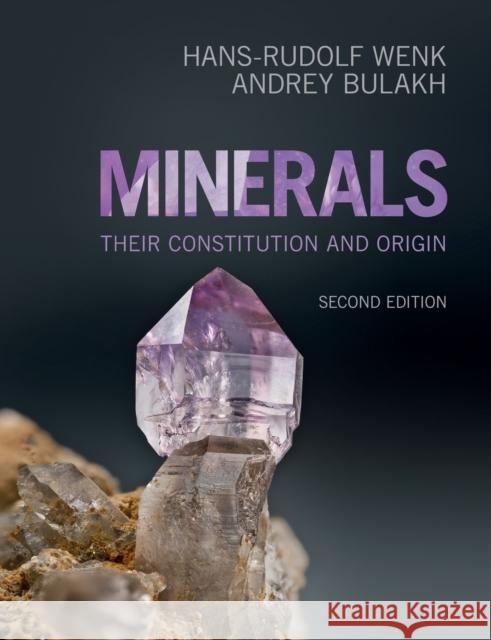Minerals: Their Constitution and Origin » książka



Minerals: Their Constitution and Origin
ISBN-13: 9781107514041 / Angielski / Miękka / 2016 / 640 str.
Minerals: Their Constitution and Origin
ISBN-13: 9781107514041 / Angielski / Miękka / 2016 / 640 str.
(netto: 237,82 VAT: 5%)
Najniższa cena z 30 dni: 246,78
ok. 22 dni roboczych
Dostawa w 2026 r.
Darmowa dostawa!
The new edition of this popular textbook once again provides an indispensable guide for the next generation of mineralogists.
Glosariusz/słownik
'Minerals: Their Constitution and Origin (second edition) by Wenk and Bulakh is an excellent treatment of classical mineralogy with a novel emphasis on mineral-forming environments. Its organization, straightforward tone, and copious figures, including color imagery, should be welcomed by students. Additional online resources permit extensive incorporation by lecturers should they desire these resources. Both make it a worthy candidate for adoption into coursework. Additionally, this is an excellent and affordable resource for professional mineralogists and amateur mineral enthusiasts who seek a comprehensive and modern overview of classical mineralogy with an emphasis on mineral genesis.' Jonathan D. Price, American Mineralogist
Part I. Minerals as Chemical Compounds: 1. Subject and history of mineralogy; 2. Elements, bonding, simple structures and ionic radii; 3. Isomorphism, solid solutions and polymorphism; 4. Chemical formulas of minerals; 5. Classification and names of minerals; 6. Mineral identification of hand specimens; Part II. Symmetry Expressed in Crystal Structures and Morphology: 7. The concept of a lattice and description of crystal structures; 8. Crystal symmetries: point groups and space groups; 9. Crystalline defects; 10. Crystal growth and aggregation; Part III. Physical Investigations and Properties of Minerals: 11. Experimental approaches to crystal structures: X-ray diffraction; 12. Physical properties; 13. Optical properties of crystals; 14. Mineral identification with the petrographic microscope; 15. Colour; 16. Advanced analytical methods; 17. Mechanical properties and deformation; Part IV. Mineral-Forming Processes: 18. Mineral genesis; 19. Considerations of thermodynamics; 20. Phase diagrams; Part V. A Systematic Look at Mineral Groups: 21. Important information about silica materials. Their occurrence in granite and pegmatite; 22. Simple compounds. Unusual mineral occurrences; 23. Halides. Evaporite deposits; 24. Carbonates and other minerals with triangular anion groups. Sedimentary origins; 25. Phosphates, sulfates and related minerals. Apatite as a biogenic material; 26. Sulfides. Hydrothermal processes; 27. Oxides and hydroxides. Review of ionic crystals; 28. Orthosilicates and ring silicates. Metamorphic mineral assemblages; 29. Sheet silicates. Weathering of silicate rocks; 30. Chain silicates. Discussion of some igneous and metamorphic processes; 31. Framework silicates. Zeolites and ion exchange properties of minerals; 32. Organic minerals; Part VI. Applied Mineralogy: 33. Metalliferous mineral deposits; 34. Gemstones; 35. Cement minerals; 36. Minerals and human health; 37. Mineral composition of the Solar System; 38. Mineral composition of the Earth; Appendix 1. Metallic, submetallic and nonmetallic luster, sorted according to hardness; Appendix 2. Minerals that display some distinctive physical properties; Appendix 3. Rock-forming minerals that are coloured in thin section; Glossary; References; Index.
Wenk, Hans-Rudolf Hans-Rudolf Wenk is Professor of the Graduate School in the Department of Earth and Planetary Science at the University of California, Berkeley. Since joining the Berkeley faculty, he has been engaged in teaching and research, covering a wide field of mineralogy, from feldspars to carbonates, metamorphic rocks to shales, and from the Earth's surface to the inner core. His particular focus has been on microstructures, investigated using electron microscopy and synchrotron X-rays. Bulakh, Andrey Andrey Bulakh is Professor in the Department of Mineralogy at St Petersburg State University. He is a specialist in mineralogy, geochemistry and the origin of alkaline rocks and carbonatites. More recently, he has studied the history of ornamental stones in architecture. He has written several books that are widely used at Russian universities, and was a long-time member of the Commission on New Minerals, Nomenclature and Classification of the International Mineralogical Association.
1997-2025 DolnySlask.com Agencja Internetowa
KrainaKsiazek.PL - Księgarnia Internetowa









